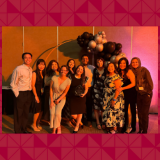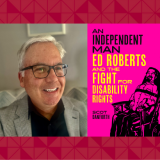How should I treat religious holidays in the classroom?
December 17, 2012
The month of December is always a festive time of year. Walk into any store and it is a holiday assault on the senses. Music, displays, food, and countless messages make it very clear. We live in a nation that is predominantly Christian. This fact has made it challenging to maintain the ideals put forth in the First Amendment’s- the separation of religion and government.
Most of us can easily recall Christmas pageants where auditoriums would be filled with video-taping parents, eager to capture their children singing carols and playing the part of Rudolph or Scrooge. Also abundant were the handmade ornaments- kindergartners hand-prints funky spools converted into little drums, and glitter galore. To attempt a balance, attempts to include Hanukkah and Kwanzaa are made.
Many traditions cross the boundaries of culture and religion. School calendars revolve around Christian celebrations, forcing some children to work out a schedule of their own. As educators, we must ask ourselves if we are marginalizing students who do not celebrate religious holidays that have gained a prominent place in our curriculum. To this end, I am sharing some resources that all teachers must reference. So much information is a click away! But first, here is an excerpt from the Freedom Forum:
How should I treat religious holidays in the classroom?
Teachers must be alert to the distinction between teaching about religious holidays, which is permissible, and celebrating religious holidays, which is not. Recognition of and information about holidays may focus on how and when they are celebrated, their origins, histories and generally agreed-upon meanings. If the approach is objective and sensitive, neither promoting nor inhibiting religion, this study can foster understanding and mutual respect for differences in belief. Teachers may not use the study of religious holidays as an opportunity to proselytize or otherwise inject personal religious beliefs into the discussion.
The use of religious symbols, provided they are used only as examples of cultural or religious heritage, is permissible as a teaching aid or resource. Religious symbols may be displayed only on a temporary basis as part of the academic lesson being studied. Students may choose to create artwork with religious symbols, but teachers should not assign or suggest such creations.
The use of art, drama, music or literature with religious themes is permissible if it serves a sound educational goal in the curriculum. Such themes should be included on the basis of their academic or aesthetic value, not as a vehicle for promoting religious belief. For example, sacred music may be sung or played as part of the academic study of music. School concerts that present a variety of selections may include religious music. Concerts should avoid programs dominated by religious music, especially when these coincide with a particular religious holiday.
This advice about religious holidays in public schools is based on consensus guidelines adopted by 18 educational and religious organizations.
To download a Teacher’s Guide to Religion in the Public Schools, I urge all teachers to visit:
http://www.freedomforum.org/publications/first/teachersguide/teachersguide.pdf
Useful Resources on Religion in the Schools and Religious Diversity for Educators
Project Interfaith, 2010
Anti- Defamation League (ADL)- Religion in the Public School
- The ADL’s handbook about the place of religion in the school systems. This online handbook covers various topics like; “Prayer in Public School,” “Religion in the Curriculum,” and other useful topics.
First Amendment Center: Religious Liberty in Public Schools
- The First Amendment Center’s website on religious liberty in public schools and the importance of teaching about religion in the social studies curriculum. This website also gives information on what to do during the holiday season, student religious practices, evolution and creation and other useful resources.
Finding Common Ground-Online Book
- Online version of the book, Finding Common Ground, by Charles Hayes and Oliver Thomas. The book is a guide to teaching religion in the public school system.
- This site gives information and resources on schools teaching about religious tolerance.
- This site gives lessons plans on diversity and making the most out of your culturally diverse classroom.
Teaching about Religion: in support of civil pluralism
- This site is dedicated to giving educators information on teaching in an increasingly diverse classroom. The site offers “World View” charts that give basic information on specific world views; such as, Christianity, Sikhism, Islam and many other religions. They also give free lesson plans.
Council of Europe- Religious Diversity and Intercultural Education: A Reference Book for Schools
- PDF form of the Council of Europe’s book Religious Diversity and Intercultural Education: A Reference Book for Schools. Although this book is to be used in European schools, it can be particularly helpful to educators in the United States as well.
- The American Academy of Religions set a number of guidelines for teaching about religion in the public school system. The guidelines help to end illiteracy about religions, which will ultimately help end prejudices towards people of different faiths and will promote the academic study of religion.
Journal of Religion and Education
- Online journal dedicated to advancing the public’s awareness on religion and education.
- From the University of California-Berkley, this sites lends tips on creating a bias free classroom from Barbara Gross Davis’ book Tools for Teaching. This site gives general tactics to create a bias free and culturally diverse classroom, as well as strategies to get rid of stereotypes already established in the classroom.
Resources on Religion
The Gallup Coexist Index 2009: A Global Study of Interfaith Relations
- The results from the 2009 Gallup survey concerning interfaith relations around the world.
The Association of Religious Data Archives
- The ARDA gives the most up-to-date data on religion. The association was originally developed for researchers in the field of religion, but has now created different features for educators, journalists and religious congregations.
- This site gives information on the history of religion in the United States, from the 17th century up to the present.
Religious Education Online (UK Site)
- This site gives resources for teacher and students on different religions. The site includes fun, interactive pages with information concerning different religions, an audio guide to religious terms, a photo bank of religious pictures and more useful topics.
- The BBC Religion website gives information on many of the world’s religions and spiritual beliefs.
- Membership is required for this site, however, they give members lesson plans and activities on a variety of topics, including; diversity, religion, and specific religious holidays.
Pew Forum on Religion and Public Life
- The Pew Forum conducts research and collects data on important religious topics in the United States.
Books
How to be a Perfect Stranger: the Essential Religious Etiquette Handbook, by Stuart M. Matlins and Arthur J. Magida, 4th Edition (December 2006 – Skylight Paths Publishing)
Handbook of Living Religions: Second Edition, by John R. Hinnells
Multicultural and Diversity Education: A Reference Handbook, by Peter Michael Applebaum
Multicultural Education: Issues and Perpectives, Seventh Edition, by James A. Banks and Cherry A. McGee Banks
Taking Religion Seriously Across the Curriculum. Haynes, Charles C., Nord. Warren A.-1998
The Role of Religion in 21st-Century Public Schools. Ed. Steven P. Jones and Eric C. Sheffield-2009
Religion and Spirituality in the Public School Curriculum by Ronald D. Anderson- 2004
Obtained from: Project Faith.
By Marisol Rexach, Ph.D. in Education Student

